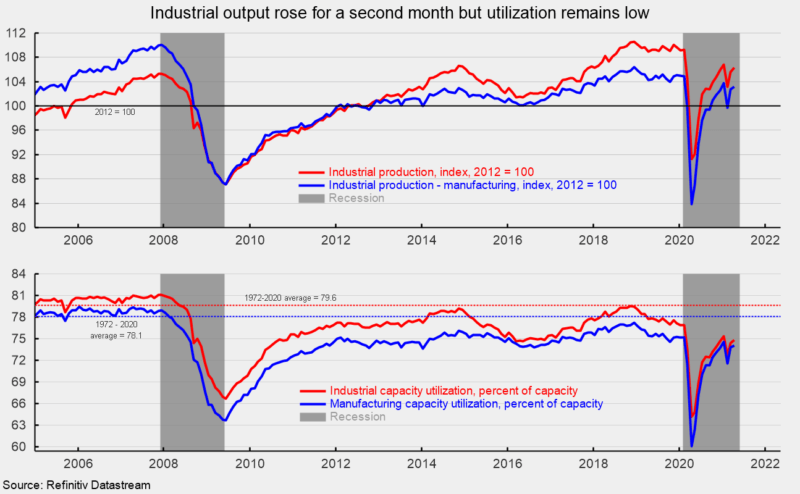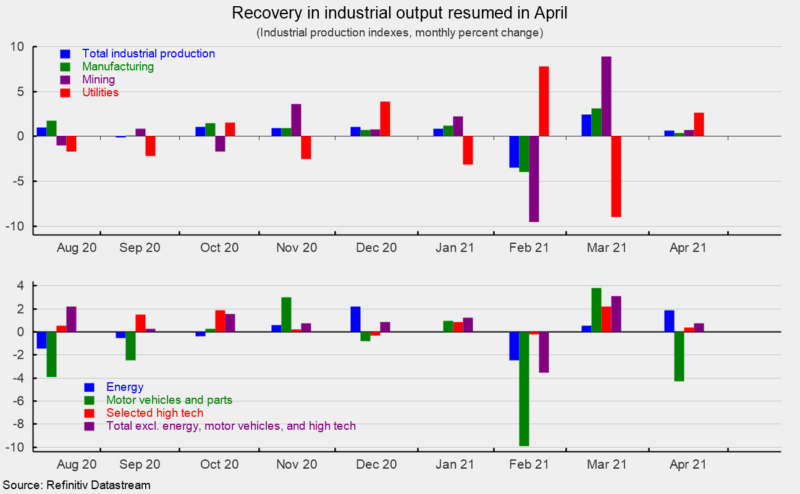Industrial Output Rises in April Despite Weakness in Autos
Industrial production rose 0.7 percent in April, a second consecutive gain following a weather-related drop of 3.5 percent in February. Manufacturing output, which accounts for about 75 percent of total industrial production, increased 0.4 percent after a drop of 4.0 percent in February and a 3.1 percent rebound in March. Over the past year, total industrial output is up 16.5 percent while manufacturing output is up 23.0 percent. However, both total industrial output and manufacturing output remain below their pre-pandemic levels (see top of first chart).
Mining output accounts for about 14 percent of total industrial output and posted a 0.7 percent increase in the latest month (see top of second chart). The rebound followed a 9.5 percent drop in February and an 8.9 percent gain in March. Over the last 12 months, mining output is down 2.4 percent.
Utility output, which is typically related to weather patterns, is about 11 percent of total industrial output, and increased 2.6 percent for the month following a 9.0 percent drop in March (see top of second chart). From a year ago, utility output is up 1.9 percent.
Among the key segments of industrial output, energy production (about 25 percent of total output) gained 1.9 percent for the month (see bottom of second chart) and is up 1.3 percent from a year ago.
Motor-vehicle production (about 5 percent of total output), one of the hardest-hit industries during the lockdowns and now suffering through a semiconductor chip shortage, sank 4.3 percent in April (see bottom of second chart). Motor-vehicle production is up 439.7 compared with April 2020, the low of the pandemic. Total vehicle assemblies fell to 9.03 million at a seasonally-adjusted annual rate. That consists of 8.68 million light vehicles and 0.35 million heavy trucks. Within light vehicles, light trucks were 7.04 million while cars were 1.64 million.
High-tech industries output rose 0.4 percent in April (see bottom of second chart) and is up 10.8 percent versus a year ago. High-tech industries account for just 1.8 percent of total industrial output.
All other industries combined (total excluding energy, high-tech, and motor vehicles; about 2/3rds of total industrial output) gained 0.6 percent in April (see bottom of second chart) and are 16.1 percent above April 2020.
Total industrial utilization rose to 74.9 percent in April from 74.4 percent in March. That is still well below the long-term (1972-2020) average utilization of 79.6 percent (see bottom of first chart). Manufacturing utilization rose 0.3 percentage points to 74.1 percent, also still well below the long-term average of 78.1 percent (see bottom of first chart).
April data on industrial output shows a continued rebound from the February decline which was severely impacted by weather and not representative of underlying economic conditions. Despite the two consecutive monthly gains, the industrial sector has a way to go before complete recovery to pre-pandemic levels of activity.
Most other recent economic data have been showing positive momentum as the combination of the ongoing distribution of vaccines and easing of government restrictions on consumers and businesses are driving the economic recovery. However, pent-up demand, materials shortages, logistical issues, and labor difficulties are combining to pressure prices. While some of these conditions may take some time to work out, the likelihood of a 1970s-style inflationary spiral is relatively low given the vastly different structure of the economy today.







